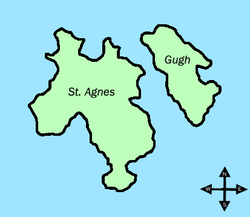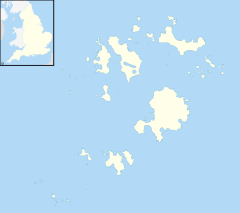Gugh
Gugh
|
|
|---|---|
 The islands of Gugh and St Agnes |
|
| Gugh shown within Isles of Scilly | |
| Population | 3 |
| Civil parish |
|
| Unitary authority | |
| Ceremonial county | |
| Region | |
| Country | England |
| Sovereign state | United Kingdom |
| Post town | ISLES OF SCILLY |
| Postcode district | TR22 |
| Dialling code | 01720 |
| Police | Devon and Cornwall |
| Fire | Isles of Scilly |
| Ambulance | South Western |
| EU Parliament | South West England |
| UK Parliament | |
Gugh (/ˈɡjuː/; Cornish: Keow, meaning "hedge banks") could be described as the sixth inhabited island of the Isles of Scilly, but is usually included with St Agnes with which it is joined by a sandy tombolo known as "The Bar" when exposed at low tide. The island is only about 1 km (½ mi) long and about 0.5 km (¼ mi wide, with the highest point, Kittern Hill at 34 m (112 ft). The geology consists of Hercynian granite with shallow podzolic soils on the higher ground and deeper sandy soils on the lower ground. The former Gugh farm is just north of the neck across the middle of the island between the two hills. The two houses were designed and built in the 1920s by Charles Hamlet Cooper. The name is often mispronounced as "Goo", "Guff" or even "Gogh".
The island lies within the Isles of Scilly Heritage Coast, is in the Isles of Scilly Area of Outstanding Natural Beauty and is managed by the Isles of Scilly Wildlife Trust. Vegetation cover is mainly wind-pruned heath or dense bracken and bramble with a small area of coastal grassland formed over blown sand which has accumulated near the bar.
In 2013 the Isles of Scilly Seabird Recovery Project was set up by a number of organisations including the RSPB and the Isles of Scilly Wildlife Trust. The five-year project aims to keep the islands of St Agnes and Gugh brown rat (Rattus norvegicus) free, to help breeding sea birds, which lost 25% of their populations between 1983 and 2006. The rats eat eggs and kill the chicks of those birds that nest in burrows or on the ground. Rat removal began in October 2013 by a team of 30 volunteers led by Wildlife Management International Limited (WMIL) of New Zealand, and there has been no signs of rats on St Agnes and Gugh since December 2013. WMIL will return to the islands to do a final check for rats in 2016.
...
Wikipedia

